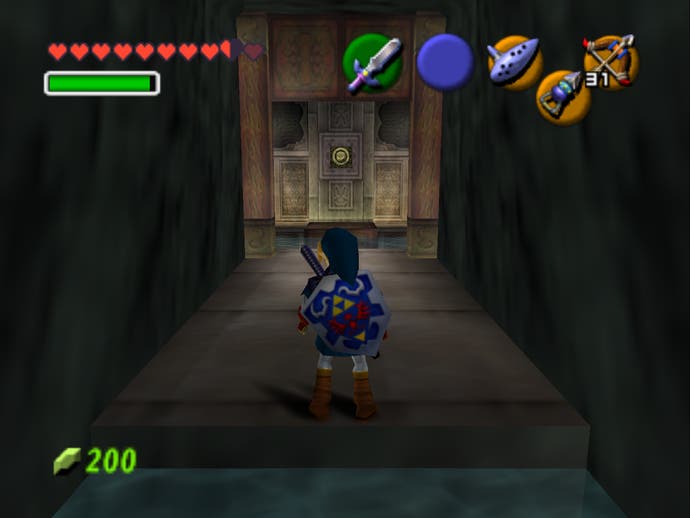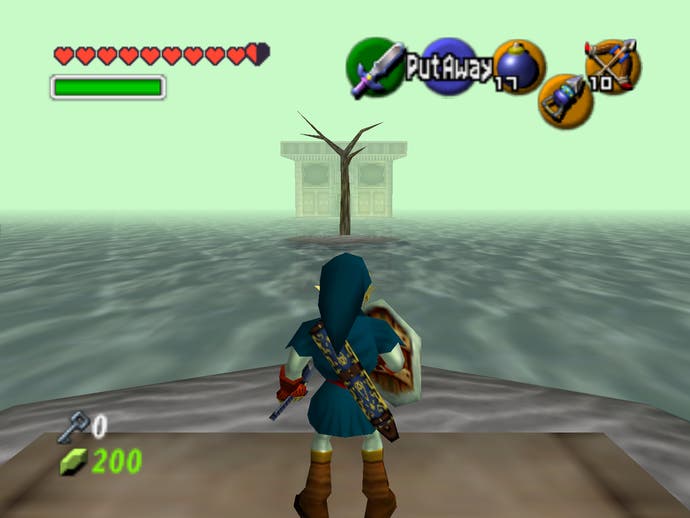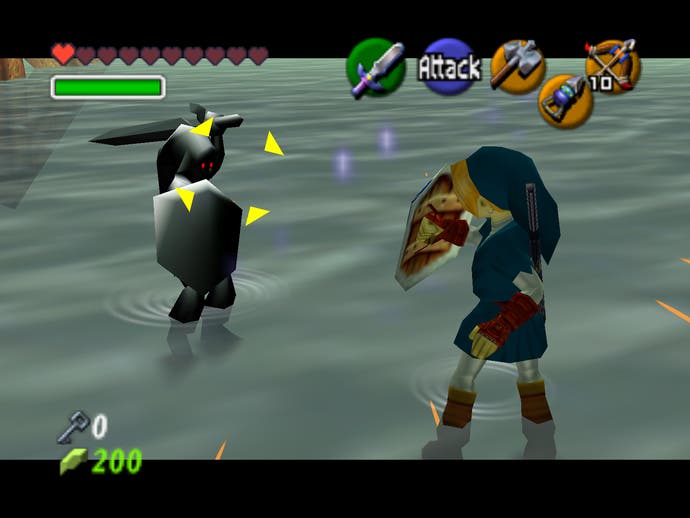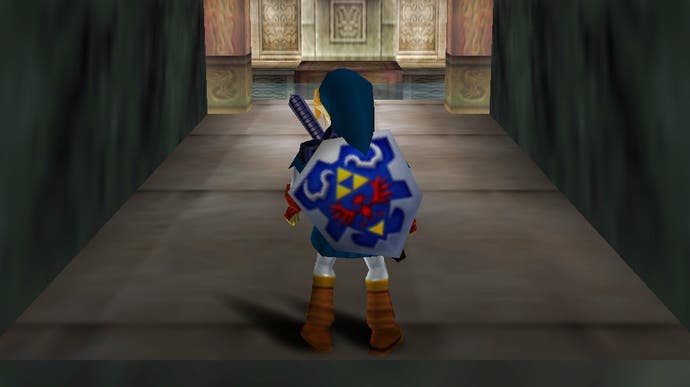The Water Temple isn't as difficult as we remember
Reentering Zelda: Ocarina of Time's infamous dungeon, 20 years on.
It's a bit like going back to visit your school as an adult: everything seems smaller than you remember.
The Legend of Zelda: Ocarina of Time, which frequently tops lists of the best video games ever, was released 20 years ago this week. Although I have started Nintendo's masterpiece again several times since I completed the game back in '98 or, more likely, '99, I have never got that far into a second playthrough. This means that it is the best part of two decades since I played the Water Temple.
This dungeon lives in infamy amongst Zelda fans. It is considered tortuously difficult, not because it is dangerous - in fact, aside from its notoriously tough midboss, it doesn't contain many threatening enemies - but because it is inscrutable. It is a deep warren of caves and corridors, linked by a tall central chamber and mostly submerged until you learn how to move the water level between three floors. Thanks to recently acquired items, our hero Link can breathe and walk underwater, but he's so buoyant he can't swim for any distance, so changing the water level greatly affects his access to parts of the dungeon. The Water Temple was designed in such a way that you need to change the water level often and revisit areas multiple times, approaching them from new directions, to acquire all the keys to all its doors and unlock all its secrets.
It stumped many players back then. Eiji Aonuma, now lead producer of the Zelda series, then one of Ocarina's directors under Shigeru Miyamoto, has since apologised for what many see as the Water Temple's wilfully obfuscated design. In the 3DS version, signposting was even added to guide players through the water level changes.

I remember spending what felt like days grappling with it, although not with the frustration many players recall. Ocarina was my first Zelda game, and I was particularly drawn to the mystery of its dungeons: these echoing, ruined spaces which constantly presented you with places you couldn't go and symbols you didn't understand, but which, through persistence and logic, you knew you would be able to untangle, to decode, stepping back into daylight afterwards wiser and more powerful. The Water Temple was the apotheosis of this to me, and I accepted its challenge humbly. Or I like to think I did, anyway.
So I decided that there would be no better way to celebrate Ocarina's 20th anniversary than by entering the Water Temple once more and seeing if its fearsome reputation is deserved. I certainly didn't remember it well enough that it couldn't stump me again. Was it a masterpiece of puzzle design that was simply too clever for its own good? Or an actually flawed construction that Nintendo was right to try to fix?
The only copy of the game I own with a save anywhere near the Water Temple is on 3DS, and for my purposes only the original Nintendo 64 version would do, so I regretfully chose to emulate the game on PC. This had the advantage that I was able to download a save right at the start of the Water Temple, with the disadvantage that I was going in cold without the preceding tens of hours of re-familiarisation with Link's adventure. I spent a good 10 minutes unable to progress past the first room - having sworn not to use any form of guide - before I remembered an important item. To quote my notes: "Oh right yeah. Iron Boots."

It's the Iron Boots that let you walk underwater, and they need to be manually selected from the Equipment menu every time you want to equip or unequip them, which in the Water Temple is all the time. It's a faff, and on 3DS they have been changed to an item that can be assigned to a one-click hot button - an unquestionable improvement. But this isn't the stuff a generation's gaming nightmares are made of. Once my brain had dusted off that decades-old muscle memory, with is accompanying jingle of menu chimes, things started to go strangely smoothly.
I'll cut to the chase: I was done in the Water Temple inside of three hours, and I didn't get stuck once.
This wasn't what I was expecting. I thought this piece would be a wry diary of gaming purgatory and a salutary reminder that the art of game design has had a lot of rough edges knocked off it in the last 20 years. Instead, to a mixture of pleasure and disappointment, I found the Water Temple made sense... mostly. It took a little while to understand that playing a melody on my ocarina in front of certain stone tablets would change the water level, and it did seem strange that the tablet that lowered the level to the first floor was actually located on the third.
For a while, I wasted time because I repeatedly forgot to look up. Ocarina's designers, understandably for those bringing Zelda into 3D for the first time, were obsessed with verticality, and liked to hide entryways and hookshot points up high, out of the line of sight. I had to go back to the central tower three times before I remembered to walk in, turn around, and then look up. It's amazing that, 20 years later, Nintendo's playful approach to 3D architecture can still trick and surprise you. Designers and players have become so wary of ever impeding the camera that such tightly packed, densely designed spaces as the Water Temple are usually avoided.

In my memory, the Water Temple is a vast, neverending labyrinth, so I was surprised at how compact it now seemed - and how simple and logical in its layout, with arms leading in the four compass points from each floor of the central chamber. Sometimes these double back and reconnect in unexpected ways, but once you have the map, paying careful attention to it will clear up the construction in your mind. Once you have the compass and can see the location of the key chests, it becomes a process of mental trial and error, plotting out which passages will be accessible as you cycle through the water levels.
Why, if I genuinely didn't remember it - and I almost entirely didn't - was I finding the Water Temple so much easier this time? I suppose it can only be the intervening 20 years of playing 3D Zelda games: Majora's Mask, The Wind Waker, Twilight Princess, Skyward Sword, and to a lesser extent the defiantly outdoorsy Breath of the Wild. Ocarina of Time established a language for 3D Zelda dungeons that has survived to this day. Pushing the boundaries of that language as it was being written, Aonuma and his team created something that we struggled to parse then but, with all that learned experience now behind us, we are fluent in now. That explains why the confounding upside-down Stone Tower from Majora's Mask didn't create such a strong reaction in players as the Water Temple had done back in 2000, but viewed on the level playing field of hindsight is probably the more challenging puzzle.

There is one moment in the Water Temple that still has the power to stop me in my tracks: that midboss, Dark Link. Ocarina has many moments of powerful, strange visual poetry, and this is one of its most potent. A chamber door opens on what appears to be a foggy lake, with a single dead tree in the middle. You splash through the shallow water, find nothing, turn around, and there's the suggestion of a figure by the tree, which slowly solidifies into your inky mirror image. Dark Link can counter your attacks because he knows what you are going to do before you do it; he is your shadow. He doesn't really have patterns and weaknesses like a normal boss, and the secret to beating him, now as then, is simply not to be discouraged. You can use certain items to help, but eventually - and especially if you let go of the crutch of Ocarina's lock-on targeting system - your blows will land and he will go down. The illusion fades and you're left standing in an empty, normal room, questioning what just happened. It's as if this extraordinary piece of anti-design - which dares to match a key with another key instead of a lock - never happened at all.
It's both comforting and a little bit sad that the Water Temple need not scare you anymore. It's tempting to say that our memories play tricks on us, but it's more accurate to say that we change and our truth changes with us. The Water Temple was hard then and isn't now, and that's thanks to the Water Temple itself: everything it taught us, and taught Nintendo, and taught a generation of game designers and players. The school hasn't shrunk. We're just bigger now.

